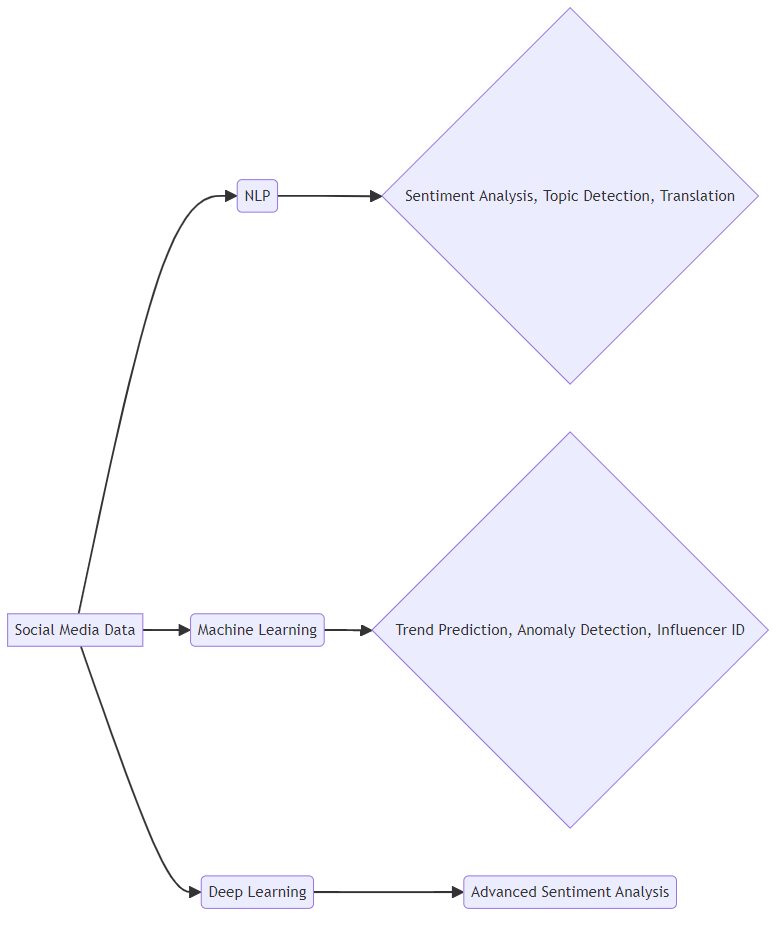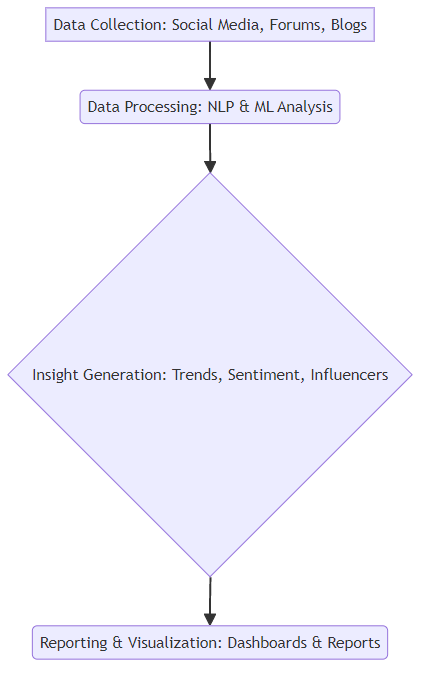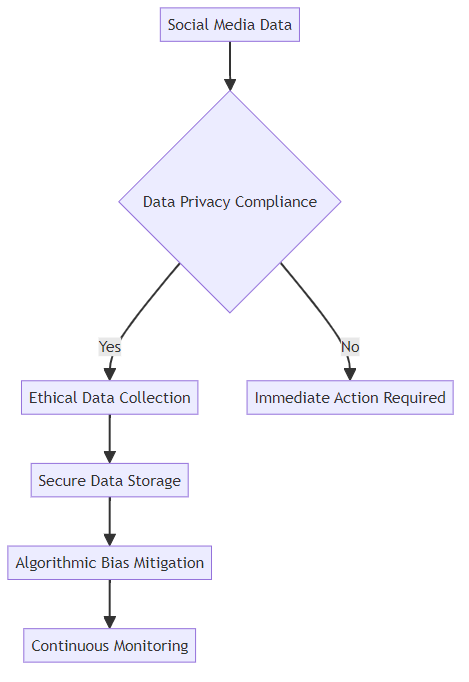AI-Powered Social Listening: A Content Strategist's Secret Weapon
Introduction: The Evolution of Social Listening in Content Strategy
Ai's impact on content strategy is undeniable, transforming how we understand and engage with audiences. But how exactly has it changed the game?
Traditional social listening involved manually tracking mentions, hashtags, and keywords. This was a time-consuming process, often relying on subjective interpretations. The limitations were clear: it was hard to scale, prone to human error, and offered limited depth.
Ai has emerged as a game-changer, automating social listening and offering scalability that manual methods simply couldn't match. Ai tools can sift through massive volumes of data, identifying patterns and sentiments with speed and accuracy. This allows for deeper, more data-driven insights into audience behavior.
The volume and velocity of social data are constantly increasing, making it nearly impossible for humans to process it all effectively. Ai helps content strategists make sense of this noise, filtering out irrelevant information and highlighting key trends. As Zapier.com notes, ai supports social media strategy with content generation, sentiment analysis, and big data insights. (AI Social Media Analytics: How AI Is Reshaping Social Strategies)
For example, ai can analyze social conversations in the healthcare industry to identify emerging concerns about specific medications, enabling content teams to address these issues proactively. In retail, ai can pinpoint trending product preferences, guiding content creation around those items. Ultimately, this leads to data-driven decision-making, improved content relevance, and increased ROI.
As ai continues to evolve, content strategists who embrace these tools will gain a significant competitive advantage. Next, we'll explore how ai enhances audience understanding through sentiment analysis.
Understanding AI-Powered Social Listening
Ai-powered social listening isn't just a trend; it's a fundamental shift in how content strategists operate, providing deeper insights and greater efficiency. But how does this technology actually work under the hood?
Ai-powered social listening relies on a few core technologies that enable it to sift through massive amounts of data and extract meaningful insights. These include:
- Natural Language Processing (NLP): NLP is the backbone of sentiment analysis, topic detection, and language translation, allowing ai to understand the nuances of human language. For example, NLP algorithms can analyze social media posts to determine whether the sentiment is positive, negative, or neutral, and it helps social listening tools understand the context of conversations. (Recent advancements and challenges of NLP-based sentiment ...)
- Machine Learning (ML): ML algorithms enable trend prediction, anomaly detection, and influencer identification. ML models can be trained to recognize patterns in social data, such as emerging trends or unusual spikes in mentions, and identify key influencers who are driving conversations. (Interactive Viral Marketing Through Big Data Analytics, Influencer ...)
- Deep Learning: Deep learning offers advanced sentiment analysis and contextual understanding, going beyond basic keyword analysis to grasp the emotional tone and intent behind social media posts. With deep learning, social listening tools can identify sarcasm, irony, and other subtle forms of expression that would be missed by traditional methods.

Ai social listening tools follow a structured process to gather, analyze, and present social data. Here’s a breakdown:
- Data Collection: Ai tools gather data from various social media platforms, forums, blogs, and news sites. This involves using apis and web scraping techniques to collect publicly available data, ensuring a comprehensive view of the social landscape. The scope can be broad, covering everything from public posts and comments to news articles and forum discussions.
- Data Processing: Nlp and ML algorithms analyze the collected data to extract relevant information. This includes identifying keywords, topics, and entities, as well as determining the sentiment and intent behind each post or comment. Nlp helps in understanding the meaning and context, while ML helps in identifying patterns and making predictions.
- Insight Generation: The ai identifies trends, sentiment patterns, and key influencers based on the analyzed data. For instance, it can detect a sudden increase in mentions of a specific product or identify a rising star in a particular industry.

Understanding how ai powers social listening tools allows content strategists to leverage these technologies effectively. Next, we'll delve into the specific ways ai enhances audience understanding through sentiment analysis.
Leveraging AI Social Listening for Content Strategy
Ai-powered social listening isn't just about tracking mentions; it's about unlocking actionable insights that drive smarter content decisions. How can you leverage ai to identify trending topics, understand audience sentiment, and optimize your content for maximum impact?
Ai excels at pinpointing emerging trends and viral topics in real-time. These tools sift through massive volumes of social data, identifying spikes in mentions, hashtags, and keywords that indicate growing interest. This allows content strategists to jump on trends while they're still hot, ensuring maximum visibility and engagement.
- Trend Discovery: Ai algorithms analyze social media conversations to identify emerging trends. For instance, in the fashion industry, ai can detect a sudden surge in interest around a specific style or designer, enabling content teams to create timely and relevant content.
- Content Ideation: Ai tools can suggest content ideas based on trending topics, helping content creators overcome creative blocks. For example, if ai identifies a growing interest in sustainable living, it can suggest blog posts, infographics, and videos on related topics.
- Predictive Analysis: Ai can predict which topics are likely to gain traction in the future, allowing content strategists to plan ahead. In finance, for example, ai can forecast emerging trends in cryptocurrency or investment strategies, guiding content creation around these topics.
Ai sentiment analysis is a game-changer for understanding how audiences feel about your brand, products, and competitors. By analyzing the emotional tone of social media posts, comments, and reviews, ai provides valuable insights into audience preferences and pain points. This allows you to tailor your content to resonate more deeply with your target audience, improving engagement and building stronger relationships.
- Sentiment Tracking: Ai sentiment analysis can track audience opinions about your brand, products, and services over time. In the food industry, ai can monitor sentiment around new menu items, helping restaurants understand customer reactions and make necessary adjustments.
- Preference Mapping: Ai can identify audience preferences based on sentiment data, allowing you to tailor content to their specific interests. For example, in the gaming industry, ai can determine which game genres or characters are most popular among different audience segments, guiding content creation around those preferences.
- Competitor Analysis: Ai can analyze sentiment around your competitors' brands, products, and services, providing valuable insights into their strengths and weaknesses. For example, identifying a competitor receiving consistently negative sentiment for customer service could suggest an opportunity for your brand to highlight its superior support.
Ai plays a crucial role in optimizing content for search engines and social media platforms. By identifying relevant keywords and hashtags, ai helps ensure that your content is easily discoverable by your target audience. Additionally, ai can optimize content titles, descriptions, and tags, further improving its visibility and reach.
- Keyword Identification: Ai algorithms analyze social data to identify relevant keywords and hashtags for your content. For example, in the travel industry, ai can pinpoint trending travel destinations or activities, helping content creators optimize their content for search engines and social media platforms.
- Content Optimization: Ai can optimize content titles, descriptions, and tags to improve its visibility and reach. For instance, ai can suggest alternative titles that are more likely to attract clicks or generate more shares.
- Performance Monitoring: Ai can track the performance of your content on social media, providing insights into which keywords, hashtags, and titles are most effective. This allows you to continuously optimize your content for maximum impact, Sprinklr unifies ai technologies within one tool.
By leveraging ai for content strategy, you can create more relevant, engaging, and effective content that drives results. In the next section, we'll explore how ai enhances social media engagement through personalized experiences.
Choosing the Right AI Social Listening Tool
Ai social listening tools offer a wealth of features, but it's easy to get lost in the noise. Knowing what to look for can help you choose the tool that best fits your content strategy needs.
When evaluating ai social listening tools, several features are crucial for content strategists:
- Data coverage: Consider which platforms the tool supports. Does it cover the social networks your audience uses? Also, check the availability of historical data, which is essential for trend analysis.
- Analytics capabilities: Look for robust sentiment analysis, trend detection, and influencer identification features. These analytics help you understand audience emotions, spot emerging topics, and find key voices in your industry.
- Reporting and visualization: Customizable dashboards and export options are vital for presenting insights. Can you easily create reports and share them with your team? Visualizations should be clear and actionable.
- Integration: Ensure the tool integrates with your existing marketing stack. Compatibility with other tools streamlines workflows and avoids data silos.
- Pricing: Evaluate the cost-effectiveness and scalability of the tool. Does the pricing model align with your budget and allow you to scale as your needs grow?
Zapier.com reviews numerous ai platforms for social media management, highlighting a range of tools with different strengths. For example, Hootsuite provides ai post prompt variety, while Emplifi offers a unified platform for social media management and customer care, according to Emplifi. Choosing the right tool depends on your specific needs and priorities.
Selecting the right ai social listening tool is a crucial step in leveraging ai for content strategy. Next, we'll explore how ai enhances social media engagement through personalized experiences.
Best Practices for Implementing AI Social Listening
Ai social listening isn't just about having the right tools; it's about using them effectively and ethically. What are the best practices for implementing ai social listening to ensure you're maximizing its potential while safeguarding data privacy and brand integrity?
It's crucial to start with clearly defined goals. These SMART (Specific, Measurable, Achievable, Relevant, Time-bound) goals will guide your ai social listening efforts and help you measure success.
- Set specific objectives: Instead of a vague goal like "improve brand sentiment," aim for something like "increase positive sentiment by 15% in the next quarter."
- Track relevant KPIs: Monitor metrics like brand mentions, sentiment score, engagement rate (likes, shares, comments), and reach. These KPIs provide quantifiable data on your progress.
- Measure ROI: Regularly assess the return on investment of your ai social listening activities. This involves comparing the costs of the tools and resources with the benefits gained, such as increased leads, sales, or brand awareness.
Complying with data privacy regulations is not optional; it's a necessity. Regulations like GDPR (General Data Protection Regulation) and CCPA (California Consumer Privacy Act) set strict rules for how you collect, store, and use personal data.
- Ethical data collection: Obtain explicit consent before collecting any personal data. Be transparent about how the data will be used and ensure users have the option to opt-out.
- Secure data storage: Implement robust security measures to protect data from unauthorized access, breaches, and cyber threats. Regularly update security protocols and conduct audits to identify and address vulnerabilities.
- Mitigating algorithmic bias: Be aware of potential biases in ai algorithms and take steps to mitigate them. For instance, regularly auditing ai models for fairness and ensuring diverse datasets are used for training can help.

Ai is a powerful tool, but it's not a replacement for human content strategists. The best approach involves combining ai insights with human creativity and expertise.
- Augment, don't replace: Use ai to automate repetitive tasks and provide data-driven insights, freeing up content strategists to focus on creative and strategic initiatives.
- Inform the creative process: Leverage ai insights to inform content creation, ensuring that content is relevant, engaging, and aligned with audience interests.
- Improve content quality: Human expertise can improve the quality and relevance of ai-generated content. Review and edit ai-generated content to ensure it's accurate, well-written, and consistent with brand voice.
"Ai is great for getting started, but knowing its limitations will help make sure your relevant content is current and well-rounded." - Tracy Rawlinson
By integrating ai effectively and ethically, content strategists can unlock new levels of efficiency and insight. Next, we'll explore how ai enhances social media engagement through personalized experiences.
The Future of AI Social Listening in Content Strategy
The future of content strategy is intertwined with ai, promising a landscape where predictive analytics and personalized content reign supreme. But what specific trends and technologies can content strategists expect?
- Predictive analytics: Ai algorithms are increasingly capable of forecasting future trends and content performance, allowing strategists to proactively tailor their content. For instance, ai can analyze social media data to predict which topics are likely to gain traction.
- Personalized content experiences: Ai enables content to be tailored to individual user preferences based on deep insights, ensuring higher engagement and relevance. For example, ai can analyze a user's past interactions to recommend content they are likely to enjoy.
- Ai-powered content creation: Ai is automating the generation of high-quality content, freeing up content teams to focus on strategy and creativity. Hootsuite has its own ai tool, OwlyWriter Ai, for writing social media captions in seconds.
The evolving role of the content strategist will see them becoming more data-savvy and ai-literate, understanding how to interpret ai insights and leverage them effectively. This means learning how to use ai tools, interpret data, and mitigate potential biases. The focus will naturally shift from manual tasks to strategic decision-making and creative oversight, allowing strategists to concentrate on high-level planning and innovation rather than repetitive tasks. Furthermore, content strategists will need to collaborate closely with ai tools and data scientists, ensuring that ai insights align with business goals and ethical standards, fostering a partnership that drives more effective and responsible content strategies.
As ai continues to evolve, content strategists who adapt to these changes will thrive. Next, we'll wrap up with a summary of how to prepare for this new era.
Conclusion: Embracing AI for Smarter Content
Ai-powered social listening has evolved from a futuristic concept to a present-day necessity for content strategists. Are you ready to harness its full potential?
Enhanced Efficiency: Ai automates data collection and analysis, saving time and resources. By automating repetitive tasks, content strategists can focus on creative and strategic initiatives.
Deeper Insights: Ai uncovers trends, sentiments, and influencer insights that drive smarter content decisions. This allows for more personalized and engaging content.
Data-Driven Decisions: Ai enables content strategists to make informed decisions based on real-time data, optimizing content performance and ROI. Continuous monitoring ensures content is relevant and impactful.
Explore Ai Tools: Dive into ai social listening platforms to discover the right fit for your content strategy needs. Experiment with tools like Hootsuite and Emplifi, each offering unique strengths.
Continuous Learning: Stay updated with the latest ai trends and best practices through webinars, blogs, and industry resources. Embrace data-savviness and ai literacy to interpret insights effectively.
Transform Content Strategy: Embrace ai to unlock new levels of efficiency, creativity, and strategic decision-making. As ai evolves, adapting to these changes will drive business success.
Embrace ai to transform your content strategy and stay ahead in the ever-evolving digital landscape. It truly is a secret weapon that empowers content strategists with a unique advantage in understanding and connecting with their audience.

